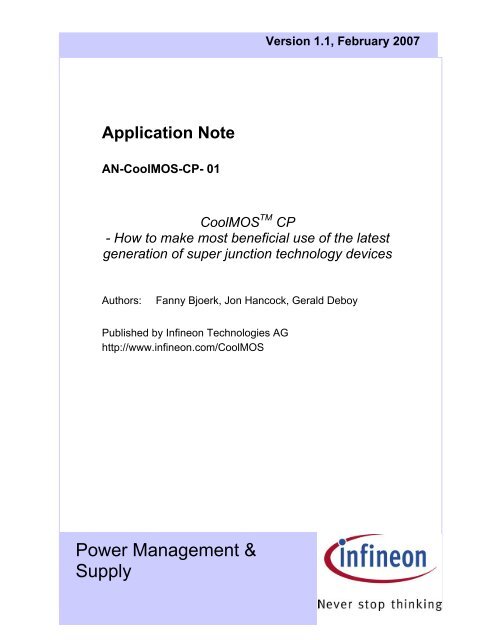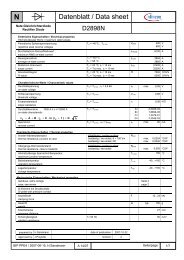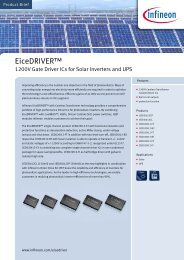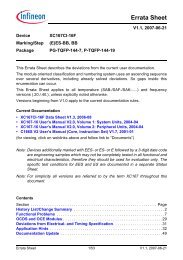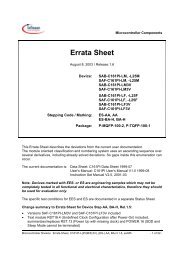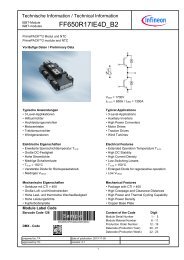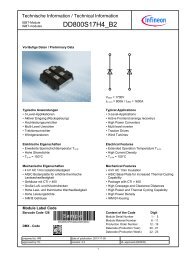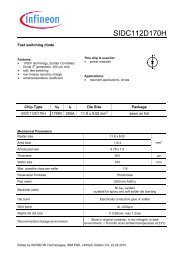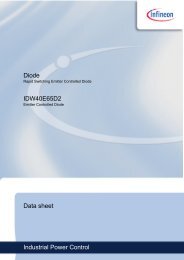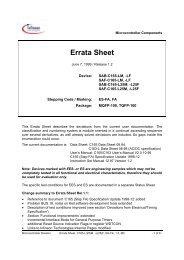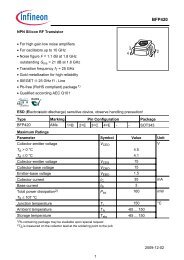Application Note CoolMOS™ CP - Infineon
Application Note CoolMOS™ CP - Infineon
Application Note CoolMOS™ CP - Infineon
You also want an ePaper? Increase the reach of your titles
YUMPU automatically turns print PDFs into web optimized ePapers that Google loves.
Version 1.1, February 2007<br />
<strong>Application</strong> <strong>Note</strong><br />
AN-CoolMOS-<strong>CP</strong>- 01<br />
CoolMOS TM <strong>CP</strong><br />
- How to make most beneficial use of the latest<br />
generation of super junction technology devices<br />
Authors:<br />
Fanny Bjoerk, Jon Hancock, Gerald Deboy<br />
Published by <strong>Infineon</strong> Technologies AG<br />
http://www.infineon.com/CoolMOS<br />
Power Management &<br />
Supply
CoolMOS TM <strong>CP</strong><br />
- How to make most beneficial use of the latest<br />
generation of super junction technology devices<br />
Revision History<br />
Actual Release: Rev.1.1 2007-02-12<br />
Previous Release: Rev.1.0<br />
Table of contents<br />
1 Introduction......................................................................................................................................................3<br />
2 Technology Comparison of CoolMOS TM <strong>CP</strong> to C3 ...........................................................................................6<br />
3 Dynamic Switching Behavior of CoolMOS TM <strong>CP</strong>..............................................................................................9<br />
4 Circuit Design and Layout Recommendations ...............................................................................................13<br />
5 MOSFET Selection for the <strong>Application</strong> Based on Loss Balance ....................................................................17<br />
6 Examples of <strong>Application</strong> Benefits with CoolMOS TM <strong>CP</strong>..................................................................................19<br />
7 Product Portfolios ..........................................................................................................................................21<br />
8 References ....................................................................................................................................................23<br />
Appendix – Typical Dynamic Switching Characteristics of CoolMOS TM <strong>CP</strong> 600V .................................................24<br />
2 of 32
CoolMOS TM <strong>CP</strong><br />
- How to make most beneficial use of the latest<br />
generation of super junction technology devices<br />
1 Introduction<br />
Today’s trend in SMPS applications of system miniaturization and efficiency improvement put tough demands on<br />
power semiconductor performance. The new CoolMOS TM <strong>CP</strong> series meets these demands by offering a dramatic<br />
reduction of drain-source on-resistance (RDSon) in a given package, ultra-low total gate charge and a very low<br />
energy stored in the output capacitance. First 600V CoolMOS TM <strong>CP</strong> products were introduced during 2005 1 , with<br />
fill-up of product spectrum and introduction of a 500V class during 2006. This application note contains technical<br />
component details and a selection guide with design considerations.<br />
Target applications for CoolMOS TM <strong>CP</strong> are server and telecom power supplies, notebook adapters, LCD TV, ATX<br />
and gaming power supplies and lighting ballasts, as outlined in Table 1. Table 2 gives a quick overview of<br />
available CoolMOS TM series today.<br />
<strong>Application</strong> PFC PWM<br />
hard switching<br />
Topology<br />
Conventional, TTF, ITTF, Flyback,<br />
Interleaved<br />
Half-bridge<br />
Adapter<br />
ATX power supplies<br />
Server / Telecom<br />
LCD / PDP TV<br />
Lighting ballasts<br />
CoolMOS TM C3*<br />
CoolMOS TM <strong>CP</strong>**<br />
PWM<br />
resonant switching<br />
ZVS phase shift, res. HB,<br />
SRC, LLC<br />
CoolMOS TM CFD<br />
* Easy to design in<br />
** Takes additional care for design-in<br />
Table 1 CoolMOS TM recommendation table for major applications.<br />
Highest reliability<br />
Market<br />
entry<br />
Voltage<br />
class [V]<br />
Special<br />
characteristic<br />
CoolMOS TM S5 1998 600 Low RDSon, Switching<br />
speed close to<br />
standard MOSFETs<br />
CoolMOS TM C3 2001 500/600/ Fast switching speed,<br />
650/800 symmetrical rise/fall<br />
time at Vgs=10V<br />
CoolMOS TM CFD 2004 600 Fast body diode, Qrr<br />
1/10 th of C3 series<br />
CoolMOS TM <strong>CP</strong> 2005 500/600 Ultra-low RDSon,<br />
ultra-low Qg, very fast<br />
switching speed<br />
Table 2 CoolMOS TM series at a glance.<br />
Vgs,th Gfs Internal Rg<br />
[V] [S] [Ohm]<br />
4.5 Low High<br />
3 High Low<br />
4 High Low<br />
3 High Low<br />
1 The CoolMOS CS series is being absorbed into CoolMOS <strong>CP</strong>, employing same technology. CoolMOS <strong>CP</strong> series will be the umbrella series<br />
for all part numbers formerly shown as CoolMOS CS, with the only modification being the suffix change to <strong>CP</strong> from CS.<br />
3 of 32
CoolMOS TM <strong>CP</strong><br />
- How to make most beneficial use of the latest<br />
generation of super junction technology devices<br />
1.1 The Superjunction principle<br />
CoolMOS TM is a revolutionary technology for<br />
high voltage power MOSFETs and designed<br />
according to the superjunction (SJ) principle<br />
[1], which in turn is based on the RESURF [2]<br />
ideas being successfully used for decades in<br />
lateral power MOSFETs. Conventional power<br />
MOSFETs suffer from the limitation of the socalled<br />
silicon limit [3], which means that<br />
doubling the voltage blocking capability<br />
typically leads to an increase in the on-state<br />
resistance by a factor of five. The silicon limit<br />
is shown in Figure 2 where the area specific<br />
on state resistance of state-of-the-art<br />
standard MOSFETs as well are indicated. SJ<br />
technology may lower the on-state resistance<br />
of a power MOSFET virtually towards zero.<br />
The basic idea is to allow the current to flow<br />
from top to bottom of the MOSFET in very<br />
high doped vertically arranged regions. In<br />
other words, a lot more charge is available for current<br />
conduction compared to what is the case in a standard<br />
MOSFET structure. In the blocking state of the SJ<br />
MOSFET, the charge is counterbalanced by exactly<br />
the same amount of charge of the opposite type. The<br />
two charges are separated locally in the device by a<br />
very refined technology, and the resulting structure<br />
shows a laterally stacked fine-pitched pattern of<br />
alternating arranged p- and n-areas, see Figure 1. The<br />
finer the pitch can be made, the lower the on-state<br />
resistance of the device will be. With every<br />
CoolMOS TM generation the pitch is reduced, moving<br />
ever closer to the zero resistance point without losing<br />
voltage blocking capability.<br />
RDSon*A [Ohm*mm 2 ]<br />
12<br />
10<br />
8<br />
6<br />
4<br />
2<br />
State-of-the-art<br />
standard MOSFETs<br />
CoolMOS TM <strong>CP</strong><br />
Si Limit<br />
CoolMOS TM C3<br />
0<br />
400 500 600 700 800 900<br />
Breakdown Voltage [V]<br />
Figure 2 Area-specific RDSon versus breakdown voltage<br />
for standard MOSFET and CoolMOS TM technology.<br />
S<br />
G<br />
D<br />
Standard MOSFET<br />
S<br />
n<br />
p +<br />
p -<br />
p<br />
n + sub<br />
G<br />
-<br />
-<br />
-<br />
n epi<br />
D<br />
- -<br />
-<br />
Superjunction MOSFET<br />
Figure 1 Schematic cross-section of a standard<br />
power MOSFET versus a superjunction MOSFET<br />
4 of 32
CoolMOS TM <strong>CP</strong><br />
- How to make most beneficial use of the latest<br />
generation of super junction technology devices<br />
Another signature of SJ technology is the extremely fast switching speed. The turn off behavior of a SJ MOSFET<br />
is not characterized by the relatively slow voltage driven vertical expansion of the space charge layer but by a<br />
sudden nearly intrinsic depletion of the laterally stacked p-n structure. This unique behavior makes the device<br />
very fast. The neutralization of these depletion layers is done via the MOS controlled turn-on of the load current<br />
for the n-areas and via a voltage driven drift current for the p-areas. SJ devices reach therefore theoretical<br />
switching speeds in the range of few nanoseconds.<br />
Figure 3 shows a comparison of the figure-of-merit RDSon*Qg between the most advanced MOSFET<br />
technologies available in the market today.<br />
30<br />
FOM = Rdson, max *Qg [Ohm*nC]<br />
25<br />
20<br />
15<br />
10<br />
5<br />
C3<br />
<strong>CP</strong><br />
Gen 1<br />
Gen 2<br />
Gen 1<br />
Gen 1<br />
Gen 2<br />
0<br />
<strong>Infineon</strong> 600V Other SJ MOS 600V Other SJ MOS 600V Best conventional<br />
MOS 600V<br />
Figure 3 Comparison of figure-of-merit Rdson,max*Qg for most advanced 600V MOSFETs available in the<br />
market.<br />
5 of 32
CoolMOS TM <strong>CP</strong><br />
- How to make most beneficial use of the latest<br />
generation of super junction technology devices<br />
2 Technology Comparison of CoolMOS TM <strong>CP</strong> to C3<br />
CoolMOS <strong>CP</strong> is the next step towards THE IDEAL HIGH VOLTAGE SWITCH with key features:<br />
Further reduced conduction and switching losses<br />
Lowest on-state-resistance per package @600V blocking capability<br />
Ultra-low gate charge and Lowest figure-of-merit R DSon x Q g<br />
… which gives the application benefits:<br />
Extremely reduced heat generation<br />
Reduced system size and weight<br />
Very low gate drive power facilitating the use of low cost ICs and gate drivers<br />
Reduced overall system cost<br />
To make an optimum MOSFET selection and apply it successfully, it’s useful to first have a clear understanding of<br />
parameter differences with its predecessors. We present the key features of CoolMOS <strong>CP</strong> to C3 series in Table<br />
3.<br />
Specification Symbol SPW20N60C3 IPW60R199<strong>CP</strong><br />
On-state resistance,<br />
R DSon 190 mΩ 199 mΩ<br />
maximum rating, 25 °C<br />
Drain current rating I D 20A 16A<br />
FOM R DSon x Q g,total 16.5 ΩnC 6.4 ΩnC<br />
Typical Gate to Source, Q gs , Q gd 11 nC, 33 nC 8 nC, 11nC<br />
Drain charge<br />
Typical C RSS @ 50 V C RSS 9 pF 20 pF<br />
Typical C RSS @ 100 V C RSS 7.5 pF 1.8 pF<br />
Energy stored in output<br />
capacitance @400V<br />
Thermal resistance, junctioncase<br />
Gate threshold voltage,<br />
min…max<br />
E OSS 10 µJ 7.5 µJ<br />
R thJC,max 0.6 K/W 0.9 K/W<br />
V GS(th) 2.1… 3.9 V 2.5… 3.5 V<br />
Table 3 Key features comparison of CoolMOS TM <strong>CP</strong> versus C3 series.<br />
6 of 32
CoolMOS TM <strong>CP</strong><br />
- How to make most beneficial use of the latest<br />
generation of super junction technology devices<br />
CoolMOS TM <strong>CP</strong> series has the world’s lowest area-specific RDSon for 500V and 600V MOSFETs, which results<br />
in lowest RDSon per package type. Figure 4<br />
shows technology advances in RDSon and<br />
1995 2006<br />
current rating for 600V class MOSFETs in TO-<br />
220 package, from a 450 mOhm conventional<br />
MOSFET to superjunction MOSFETs. A TO-220<br />
package in <strong>CP</strong> technology can handle an<br />
outstanding high continuous drain current of<br />
more than 30 A.<br />
0.50<br />
0.45<br />
0.40<br />
0.35<br />
RDSon,max<br />
50<br />
45<br />
40<br />
35<br />
As the chip size for a given RDSon rating is<br />
smaller in <strong>CP</strong> technology compared to C3, the<br />
thermal impedance is higher and thus the<br />
current rating is slightly lower when comparing<br />
same RDSon. However, MOSFET selection<br />
should be made based on system thermal<br />
requirements, which means RDSon selection,<br />
and not on current rating. The slightly lower<br />
rating for <strong>CP</strong> compared to C3 has no affect in<br />
the majority of applications as nominal peak and<br />
rms currents are far below the rated currents in<br />
the datasheet. For peak current capability, there<br />
is no compromise between <strong>CP</strong> and C3 series.<br />
The improvements in dynamic characteristics<br />
are substantial in CoolMOS TM <strong>CP</strong>. As shown in<br />
Figure 5, the gate to drain charge, Qgd, is<br />
greatly reduced and contributes to lower turn-on<br />
time and turn-off time. Furthermore, the output<br />
capacitance is as well reduced resulting in lower<br />
energy stored in the output capacitance, Eoss,<br />
for VDS=400V which is a key value for PFC and<br />
ZVS full-bridge topologies. As a consequence<br />
turn-on and turn-off switching power losses drop<br />
considerably for <strong>CP</strong> compared with C3 as seen<br />
in Figure 6. Eon is reduced by a factor of two,<br />
while Eoff is reduced by a factor of 3.3.<br />
RDSon,max [Ohm]<br />
0.30<br />
0.25<br />
0.20<br />
0.15<br />
0.10<br />
0.05<br />
0.00<br />
ID at 25 °C<br />
Standard<br />
MOSFET<br />
450mOhm<br />
Current capability per package<br />
increases with lower RDSon<br />
Standard<br />
MOSFET<br />
420mOhm<br />
Other SJ<br />
CoolMOS C3<br />
MOSFET<br />
190mOhm<br />
290mOhm<br />
30<br />
25<br />
20<br />
15<br />
10<br />
5<br />
0<br />
Other SJ<br />
CoolMOS <strong>CP</strong><br />
MOSFET<br />
99mOhm<br />
170mOhm<br />
Figure 4 RDSon,max and nominal current rating for<br />
TO220 packages, showing technology advances over<br />
time for 600 V rated MOSFETs.<br />
Gate voltage Vgs [V]<br />
12<br />
10<br />
8<br />
6<br />
4<br />
2<br />
0<br />
Lowest total gate charge,<br />
best FoM Ron*Qg<br />
Lowest Qgd,<br />
best ratio Qgd / Qgs<br />
190 mΩ C3 series<br />
199 mΩ <strong>CP</strong> series<br />
0 20 40 60 80 100<br />
Gate charge [nC]<br />
Figure 5 Gate charge characteristics comparison C3,<br />
<strong>CP</strong>.<br />
ID t 25 °C [A]<br />
7 of 32
CoolMOS TM <strong>CP</strong><br />
- How to make most beneficial use of the latest<br />
generation of super junction technology devices<br />
10<br />
Eoss [µ]<br />
8<br />
6<br />
4<br />
190mOhm C3 series<br />
199 mOhm <strong>CP</strong> series<br />
2<br />
0<br />
0 100 200 300 400 500<br />
Voltage [V]<br />
Figure 6 Comparison of energy stored in output capacitance <strong>CP</strong> to<br />
C3.<br />
400<br />
Switching losses Eon, Eoff [µJ]<br />
300<br />
200<br />
100<br />
C3 190 mOhm Eon<br />
<strong>CP</strong> 199 mOhm Eon<br />
C3 190 mOhm Eoff<br />
<strong>CP</strong> 199 mOhm Eoff<br />
0<br />
0 20 40 60 80<br />
Gate resistance [Ohm]<br />
Figure 7 Comparison of switching power losses, <strong>CP</strong> vs. C3.<br />
8 of 32
CoolMOS TM <strong>CP</strong><br />
- How to make most beneficial use of the latest<br />
generation of super junction technology devices<br />
3 Dynamic Switching Behavior of CoolMOS TM <strong>CP</strong><br />
MOSFET switching is governed first and foremost about<br />
resistances (gate input) and capacitances (gate to source<br />
Cgs, gate to drain Cgd, and source to drain Cds), see<br />
Figure 8. With the very fast switching speed of CoolMOS<br />
<strong>CP</strong>, secondary effects become as well important, such as<br />
the influence of source circuit inductance and drain to<br />
source output capacitance. Behaviors may be seen, which<br />
are not usually encountered with conventional MOSFETs.<br />
Understanding these behaviors and using them to<br />
advantage within safe limits in the application requires a<br />
deeper look into the MOSFET switching behavior. Turn-on<br />
behavior is usually strongly influenced by the application<br />
circuit and associated components, but turn-off behavior is<br />
usually controlled just by the MOSFET, so this is the mode<br />
which will be examined closely in this section.<br />
<strong>Note</strong> that for correlation with standard data sheet terms,<br />
Ciss = Cgs + Cgd, Crss = Cgd, and Coss = Cds + Cgd.<br />
Figure 8 Elements controlling MOS switching.<br />
3.1 Gate Controlled MOSFET Switching<br />
Considering the diagram of Figure 9, the gate controlled<br />
MOSFET turn-off occurs in three fairly discrete intervals,<br />
and the behavior and losses for each interval is described<br />
separately below:<br />
In the interval t1, the gate voltage is discharged to the<br />
current plateau level by the driver, with a time determined<br />
largely by Ciss, the gate input resistance RG, and the<br />
operating voltage levels for the gate drive and the plateau<br />
voltage determined by the MOSFET gfs and load current:<br />
⎛<br />
t1 = R G<br />
⋅C iss<br />
⋅ ln V − V ⎞<br />
GDrv G −Off<br />
⎜<br />
V Plat<br />
− V<br />
⎟<br />
⎝<br />
G −Off ⎠<br />
(1)<br />
In the interval t2, the MOSFET is acting like an integrating<br />
amplifier, and the gate current supplied through Rg is that<br />
needed to charge Cgd as VDS rises, even while full ID<br />
current flows:<br />
t2 = R G ⋅ C rss ⋅V DS<br />
V Plat<br />
− V G−Off<br />
Figure 9 Example of gate controlled turn-off<br />
switching.<br />
(2)<br />
During this gate controlled interval, where dVDS/dt is controlled by gate drive, the actual rate of change can be<br />
described by:<br />
dV DS<br />
dt<br />
= V Plat<br />
− V G−Off<br />
R G<br />
⋅ C Rss<br />
(3)<br />
In the final portion of turn-off, the gate drops below the plateau region, as RG discharges Ciss further, and ID falls<br />
following the MOSFET transfer function for ID as a function of VGS.<br />
⎛<br />
t3 = R G<br />
⋅ C iss<br />
⋅ ln V Plat<br />
− V G−Off<br />
⎞<br />
⎜<br />
⎝ V th<br />
− V<br />
⎟<br />
G−Off ⎠<br />
(4)<br />
9 of 32
CoolMOS TM <strong>CP</strong><br />
- How to make most beneficial use of the latest<br />
generation of super junction technology devices<br />
This turn-off behavior is shown in the simulation<br />
results of Figure 10, displaying the gate input<br />
waveform, drain to source voltage, and drain<br />
current. In this mode, the gate drive retains<br />
complete control over the dv/dt of the MOSFET,<br />
and is directly sizable by adjusting the size of<br />
the gate input resistor. However, as gate charge<br />
becomes lower in MOSFETs, and output<br />
capacitance non-linearity increases, using small<br />
values of gate drive resistance eventually shifts<br />
the switch-off behavior into a different mode.<br />
Discharging 24<br />
the<br />
input capacitance Cgs + Cgd<br />
Gate voltage [V], Drain current [A]<br />
20<br />
16<br />
12<br />
8<br />
4<br />
Charging Cds<br />
Falling ID<br />
Vgs C3 [V]<br />
Ids C3 [A]<br />
Vds C3 [V]<br />
Discharging Cgs + Cgd<br />
500<br />
400<br />
300<br />
200<br />
100<br />
Charging Cgd<br />
0<br />
0<br />
0 20 40 60 80 100 120<br />
Time [ns]<br />
Drain voltage [V]<br />
3.2 Quasi-ZVS Switching<br />
Figure 10 Turn-off simulation of CoolMOS TM .<br />
Under conditions in which the gate drive turn-off is very fast, in<br />
combination with a relatively high Coss (as can exist in<br />
superjunction MOSFETs when the drain to source voltage is below<br />
50V), the switching behavior will be dominated by somewhat<br />
different mechanisms, and the drain switching voltage will not be<br />
controlled by the gate drive current, but by Coss and load current.<br />
The behavior can still be roughly described by three main states<br />
Figure 11 but externally measured gate drive or drain current can be<br />
misleading in identifying these states. The t1 state is governed<br />
similarly as for the gate controlled dv/dt mode; the difference arises<br />
in the t2 region, where the gate discharging current is at such a high<br />
level such that the load current cannot begin to charge a voltage<br />
across COSS, and the channel current is turned off before the drain<br />
to source voltage rises. This is approximately described by:<br />
⎛<br />
t2 = R G<br />
⋅C iss<br />
⋅ln V Plat<br />
− V G−Off<br />
⎞<br />
⎜<br />
⎝ V th<br />
− V<br />
⎟<br />
Figure 11 Quasi-ZVS Coss<br />
G−Off ⎠<br />
(5)<br />
controlled turn-off.<br />
This mode does result in very low turn-off losses, but it has some characteristics to consider that can become an<br />
issue in some applications, especially PFC converters with wide range of input current, and brief but high<br />
overloads.<br />
Examining the capacitance curves of the two technologies, it is clear that CoolMOS <strong>CP</strong> has a substantially<br />
higher output capacitance below 50V. This is due to the smaller cell pitch compared to C3. As blocking voltage<br />
develops, around 50V there is a much more abrupt transition from a P-column structure to a planar depletion<br />
region, resulting in an order of magnitude drop<br />
in output capacitance over a small voltage<br />
10000<br />
range. This is the “ideal” characteristic for a low<br />
Ciss <strong>CP</strong><br />
loss non-linear ZVS snubber - it keeps the<br />
Crss <strong>CP</strong><br />
output voltage rate of rise low initially while gate<br />
Coss <strong>CP</strong><br />
1000<br />
voltage is completing turn-off. Then, the output<br />
Ciss C3<br />
Crss C3<br />
capacitance drops to a very low level, around<br />
Coss C3<br />
50 pF, permitting a very fast drain voltage rise.<br />
100<br />
However, any possibility of drain control is lost<br />
because the low Qgd gate design means that<br />
gate-drain overlap capacitance is absolutely<br />
minimized, and as a result Crss drops to an<br />
10<br />
astonishingly low value, less than 2 pF above<br />
60V.<br />
Capacitances [pF]<br />
The impact of this can be seen even in<br />
simulation, where the dv/dt is controlled by<br />
Coss and load current in examples at 5A, 10A,<br />
10 of 32<br />
1<br />
0 10 20 30 40 50 60 70 80 90 100<br />
Drain Source voltage Vds [V]<br />
Figure 12 Device capacitances IPP60R385<strong>CP</strong> vs.<br />
SPP11N60C3.
CoolMOS TM <strong>CP</strong><br />
- How to make most beneficial use of the latest<br />
generation of super junction technology devices<br />
and 30 (Figure 14). The Coss-controlled dv/dt is nearly doubled for <strong>CP</strong> compared to C3. In order to avoid<br />
excessively high dv/dt values, the first<br />
recommendation is to keep the turn-off transition<br />
600<br />
in the gate controlled region under the highest<br />
load current condition occurring in the application.<br />
500<br />
For example, in a forward converter the operating<br />
current range is relatively limited, and operating<br />
870 V/ns !<br />
144 V/ns 80 V/ns<br />
current tends to be low- Coss controlled turn-off<br />
400<br />
will not result in potentially destructive dv/dt.<br />
However, in boost converters for PFC, the peak<br />
300<br />
<strong>CP</strong>, turn off at 5A<br />
current is not necessarily under direct gate<br />
<strong>CP</strong>, turn off at 10A<br />
200<br />
control, considering issues like input voltage<br />
<strong>CP</strong>, turn off at 30A<br />
transients and response delays in an average<br />
current mode controller. In that case, more care<br />
100<br />
C3, turn off at 5A<br />
C3, turn off at 10A<br />
C3, turn off at 30A<br />
must be exercised.<br />
The key to reliability under all conditions is<br />
maintaining device control. This means using gate<br />
drive to limit excessive di/dt and dv/dt by using the<br />
correct range for gate driver resistance. This is in<br />
principle no difference for CoolMOS <strong>CP</strong> than for<br />
C3. Transconductance for the two<br />
generations are actually quite similar, as the<br />
comparison in Figure 13 shows (190 mΩ C3,<br />
199 mΩ <strong>CP</strong>). What happens when gate<br />
driver resistors are chosen outside a<br />
reasonable operating range? This is<br />
examined in the context of the 199/190 mΩ<br />
<strong>CP</strong>/C3 MOSFETs in next paragraph.<br />
Drain current Ids [A]<br />
160<br />
120<br />
80<br />
Drain source voltage Vds [V]<br />
0<br />
0 5 10 15 20 25 30<br />
Time [ns]<br />
Figure 14 dv/dt simulation of <strong>CP</strong>, C3<br />
<strong>CP</strong> at Vds 20 V<br />
C3 at Vds 20 V<br />
C3 at Vds 400 V<br />
<strong>CP</strong> at Vds 400 V<br />
With very low values of gate driver<br />
resistance, di/dt is not under control of the<br />
MOSFET, but instead by the surrounding<br />
40<br />
circuit elements. This is demonstrated in<br />
Figure 15 with the gate input resistor of<br />
6.8 Ohm for an IPW60R199<strong>CP</strong>, and di/dt<br />
0<br />
that rises quite rapidly with load current, until<br />
0 2 4 6 8 10<br />
limited by external parasitic inductance. In<br />
Gate voltage Vgs [V]<br />
this case di/dt can reach thousands of<br />
amperes per microsecond. With the gate Figure 13 Transconductance characteristics of <strong>CP</strong>, C3<br />
resistor raised to 68 ohms, the picture is very<br />
different, and the rate of charging Cgs controls the di/dt independent of drain circuit loading, keeping peak di/dt in<br />
this case to a reasonable but fast 700A/µsec. A similar situation exists for controlling dv/dt, as would be expected.<br />
11 of 32
CoolMOS TM <strong>CP</strong><br />
- How to make most beneficial use of the latest<br />
generation of super junction technology devices<br />
4200<br />
180<br />
di/dt, turn off [A/µs]<br />
3500<br />
2800<br />
2100<br />
1400<br />
C3 at Rg=3.6 Ohm<br />
<strong>CP</strong> at Rg=6.8 Ohm<br />
<strong>CP</strong> at Rg=68 Ohm<br />
No gate control, excessive di/dt<br />
transition region<br />
dv/dt, turn off [V/ns]<br />
150<br />
120<br />
90<br />
60<br />
C3 at Rg=3.6 Ohm<br />
<strong>CP</strong> at Rg=6.8 Ohm<br />
<strong>CP</strong> at Rg=68 Ohm<br />
dv/dt limited by Coss<br />
transition region<br />
700<br />
Full control by Rg,<br />
no current dependency on di/dt<br />
0<br />
0 5 10 15 20 25<br />
Load current [A]<br />
30<br />
dv/dt controlled by Rg<br />
0<br />
0 5 10 15 20 25<br />
Load current [A]<br />
Figure 15 Left: di/dt for different load currents and gate drive resistance. Right: dv/dt for different load<br />
currents and gate drive resistance<br />
In the case of IPW60R199<strong>CP</strong> with a gate resistor of 6.8 ohms, the turn-off is very fast, due to low gate<br />
charge and low output capacitance above 50V. The dv/dt shows a linear rise with increasing load current,<br />
indicating true ZVS turn-off of the MOS channel, and rise of drain voltage which is only a function of how fast<br />
the output load current can charge the output capacitance C OSS .<br />
The red curves shows what is called “transition region” behavior for C3 CoolMOS, as the dv/dt is not<br />
completely controlled by output load current, and some gate control is still evident. With a gate resistance of<br />
68 ohms, CoolMOS <strong>CP</strong> shows complete control of switching behavior by the gate, and drain to source<br />
dv/dt which is nearly invariant of load current. In this mode, the MOSFET is operating as an<br />
inverting/integrating amplifier, with the gate as a virtual AC ground. This is why the plateau region is fixed in<br />
voltage during switching. There is no feedback resistor, only the “integration” capacitance from the MOSFET<br />
C RSS (gate to drain capacitance). At about 25 V/ns, drain switching speed is still fairly high compared with<br />
conventional MOSFETs, while remaining completely in control.<br />
To summarize, dv/dt during turn off is limited either by discharging the gate-drain capacitance (Rg<br />
control) or by the charging rate of the output capacitance (Coss limited).<br />
12 of 32
CoolMOS TM <strong>CP</strong><br />
- How to make most beneficial use of the latest<br />
generation of super junction technology devices<br />
4 Circuit Design and Layout Recommendations<br />
There are a number of recommendations to make with regards to circuit design and layout practices which will<br />
assure a combination of high performance and reliability. They can be recommended as if “in order of<br />
importance”, but realistically all are important, both in contribution toward circuit stability and reliability as well as<br />
overall efficiency and performance. They are not that dissimilar to recommendations made for the introduction of<br />
MOSFETs compared to bipolar transistors, or CoolMOS compared with standard MOSFETs; it is a matter of the<br />
degree of care.<br />
4.1 Control dv/dt and di/dt by proper selection of gate resistor<br />
In order to exert full Rg control<br />
on the device maximum turn-off<br />
dv/dt we recommend the<br />
following procedure:<br />
1. Check for highest<br />
peak current in the<br />
application.<br />
2. Choose Rg<br />
accordingly not to<br />
exceed 50V/ns.<br />
3. At normal operation<br />
condition quasi ZVS<br />
condition can be<br />
expected, which<br />
gives best efficiency<br />
results.<br />
dv/dt, Turn Off [V/µs]<br />
200000<br />
180000<br />
160000<br />
140000<br />
120000<br />
100000<br />
80000<br />
60000<br />
40000<br />
20000<br />
Rg= 3.3 ohm<br />
Rg= 6.8 ohm<br />
Rg= 13 ohm<br />
Rg= 33 ohm<br />
Rg= 68 ohm<br />
0<br />
0 2 4 6 8 10 12 14 16 18<br />
Load Current [A]<br />
Figure 16 dv/dt for different load currents and gate drive resistances<br />
for IPW60R199<strong>CP</strong> (switching to 400V, Tj=125 °C).<br />
Table 4 gives the Rg values for 50 V/ns and 30 V/ns at rated nominal current for each part as a quick<br />
guideline. Figure 16 also shows the turn-off dv/dt behavior for IPW60R199<strong>CP</strong> with several Rg values from<br />
3.3 Ohms to 68 Ohms. An Rg value of 30 Ohm looks fairly optimal in order to exert full Rg for high currents<br />
and still keep quasi ZVS condition at lower currents. Keep in mind that the gate resistor scales with device<br />
size and area related capacitance. The value for Rg inversely scales with different MOSFETs. Further<br />
detailed switching characteristics can be found in Appendix.<br />
CoolMOS TM Type RDSon,max ID Rg for dv/dt < 50V/ns Rg for dv/dt < 30V/ns<br />
IPP60R385<strong>CP</strong> 385 mΩ 9 A 30 Ω 64 Ω<br />
IPP60R299<strong>CP</strong> 299 mΩ 11 A 30 Ω 62 Ω<br />
IPP60R199<strong>CP</strong> 199 mΩ 16 A 30 Ω 60 Ω<br />
IPP60R165<strong>CP</strong> 165 mΩ 21 A 26 Ω 50 Ω<br />
IPP60R125<strong>CP</strong> 125 mΩ 25 A 19 Ω 37 Ω<br />
IPP60R099<strong>CP</strong> 99 mΩ 31 A 15 Ω 28 Ω<br />
IPW60R045<strong>CP</strong> 45 mΩ 60 A 10.5 Ω 17.5 Ω<br />
Table 4 Design guideline showing necessary gate resistance values for reaching dv/dt turn off values<br />
below 50 V/ns and 30 V/ns, respectively.<br />
13 of 32
CoolMOS TM <strong>CP</strong><br />
- How to make most beneficial use of the latest<br />
generation of super junction technology devices<br />
4.2 Minimize parasitic gate-drain board capacitance<br />
Particularly care must be spent on the coupling capacitances between gate and drain traces on the PCB. As fast<br />
switching MOSFETs are capable to reach extremely high dv/dt values any coupling of the voltage rise at the drain<br />
into the gate circuit may disturb proper device control via the gate electrode. As the CoolMOSTM <strong>CP</strong> series<br />
reaches extremely low values of the internal Cgd capacitance (Crss in datasheet), we recommend keeping layout<br />
coupling capacitances below the internal capacitance of the device to exert full device control via the gate circuit.<br />
Figure 17 shows a good example, where the gate and drain traces are either perpendicular to each other or go<br />
into different directions with virtually no overlap or paralleling to each other. A “bad “ layout example is shown as<br />
reference to the good layout in Figure 19.<br />
If possible, use source foils or ground-plane to shield the gate from the drain connection.<br />
4.3 Use gate ferrite beads<br />
We strongly recommend the use of ferrite beads in the gate as close as possible to the gate electrode to<br />
suppress any spikes, which may enter from drain dv/dt into the gate circuit. As the ferrite bead sees a peak pulse<br />
current determined by external Rg and gate drive, it should be chosen for this pulse current. Choose the ferrite<br />
bead small enough in order not to slow down normal gate waveforms but attenuation enough to suppress<br />
potential spikes at peak load current conditions. A suitable example is Murata BLM41PG600SN1, in an 1806<br />
SMD package. It is rated for 6A current and a DCR of 10 mOhms, with about 50-60 Ohms effective attenuation<br />
above 100 Mhz.<br />
4.4 Locate gate drivers and gate turn-off components as close as possible to the gate.<br />
Always locate the gate drive as close as possible to the driven MOSFET and the gate resistor in close proximity<br />
of the gate pin (as an example, see R1 in Figure 17). This prevents it acting as an antenna for capacitively<br />
coupled signals. The controller/IC driver should be capable of providing a strong “low” level drive with voltage as<br />
near to ground as possible- MOS or bipolar/MOS composite output stages work well in that regard, due to low<br />
output saturation voltages. While some drivers may be deemed to have sufficient margin under static or “DC”<br />
conditions, with ground bounce, source inductance drop, etc, the operating margin to assure “off” mode can<br />
quickly disappear.<br />
4.5 Use symmetrical layout for paralleling MOSFETs, and good isolation of Gate drive between FETs<br />
We recommend the use of multi-channel gate drivers in order to have separate channels for each MOSFET.<br />
Physical layout should be as symmetrical as possible, with the low impedance driver located as close as possible<br />
to the MOSFETs and on a symmetric axis.<br />
4.6 How to best make of use of the high performance of CoolMOS TM <strong>CP</strong><br />
To summarize, below recommendations are important when designing in CoolMOS TM<br />
efficiency with clean waveforms and low EMI stress.<br />
<strong>CP</strong> to reach highest<br />
Control dv/dt and di/dt by proper selection of gate resistor<br />
Minimize parasitic gate-drain capacitance on board<br />
Use gate ferrite beads<br />
Locate gate drivers and gate turn-off components as close as possible to the gate<br />
Use symmetrical layout for paralleling<br />
14 of 32
CoolMOS TM <strong>CP</strong><br />
- How to make most beneficial use of the latest<br />
generation of super junction technology devices<br />
Two independent<br />
Totem Pol Drivers<br />
as close as<br />
possible to the<br />
MOSFET!<br />
Minimized couple<br />
capacitance<br />
between gate and<br />
drain pin!<br />
View Top Layer<br />
View Bottom Layer<br />
Heatsink<br />
Heatsink<br />
Separate and short<br />
source inductance to<br />
reference point for gate<br />
drive!<br />
Heatsink is connected to source (GND)!!<br />
Figure 17 Good layout example ensuring clean waveforms when designing in CoolMOS TM <strong>CP</strong>.<br />
Figure 18 Good layout example showing schematic for PCB layout in Figure 17.<br />
15 of 32
CoolMOS TM <strong>CP</strong><br />
- How to make most beneficial use of the latest<br />
generation of super junction technology devices<br />
High source inductance<br />
-<br />
GND connection of the<br />
decoupling capacitor C2<br />
far away from the driver<br />
stage<br />
Decoupling<br />
capacitor far away<br />
from gate pin of<br />
the MOSFET & ONLY<br />
One Driver Stage<br />
for two MOSFET<br />
Heatsink<br />
High parasitic<br />
capacitance between<br />
gate and drain!<br />
Figure 19 Bad layout example.<br />
Figure 20 Schematic for bad layout example in Figure 19.<br />
16 of 32
CoolMOS TM <strong>CP</strong><br />
- How to make most beneficial use of the latest<br />
generation of super junction technology devices<br />
5 MOSFET Selection for the <strong>Application</strong> Based on Loss Balance<br />
Final thoughts will be offered on optimizing the SMPS performance and cost through analysis of loss balance. For<br />
any given MOSFET technology there is a figure of merit based upon the balance of resistive losses and dynamic<br />
losses.<br />
Improved MOSFET technologies will offer lower Coss related losses in proportion to Ron. If a specific application<br />
is examined with regards to the RMS conduction loss based on the variable RDS[on] and the switching loss<br />
based on dynamic factors (usually a combination of Coss pumping loss and crossover transition loss) a chip size<br />
with even balance of losses will provide the minimum total loss at the full load operating point. However, the<br />
slopes of the loss factors are not equivalent, and so considering the widest range of operating loads, the best<br />
efficiency and economics may occur working in a mode with higher conduction than switching losses at full load,<br />
especially in the case of redundant configured power supplies that normally operate at less than 1/2 of rated<br />
maximum output.<br />
The analysis problem can be approached from a few different angles. Let’s take as a starting example an<br />
interleaved two transistor forward converter (ITTF) designed for 1 kW output power, with the assumption of about<br />
90% efficiency, which will require an input power of about 1100W. The maximum output current in the switches at<br />
minimum bus voltage has been calculated using:<br />
where VIn_min is the minimum operating bulk bus voltage, POut_Max is the output power, and Dmax is the<br />
calculated maximum duty cycle (based on transformer turns ratio primary to secondary). Let’s say that as a first<br />
pass the best in class TO220 600V <strong>CP</strong> CoolMOS is chosen for consideration due to its very low RDS[on] for<br />
this package type. Then, the conduction loss can be calculated for an elevated junction temperature RDS[on] of<br />
150 mΩ from<br />
(6)<br />
This looks good, but perhaps too good? What about dynamic losses? As a first cut, the Coss pumping losses can<br />
be estimated from the energy equivalent output capacitance (CO(ER)) (integrated over 0 to 480V) in the<br />
datasheet:<br />
(7)<br />
Notice the imbalance in losses in this preliminary calculation. Switching losses can be further investigated using<br />
Eon and Eoff curves. These curves can be found in Appendix. The principle is the same, multiplying Eon and Eoff<br />
times the switching frequency, and summing the results.<br />
Another more conventional, perhaps simplistic, approach is to estimate the dynamic losses just from the<br />
crossover times (Eqn 9), which may be reasonably valid in the gate control switching region discussed earlier.<br />
(8)<br />
The picture which is clearly emerging, though, is that for a 1 kW, 130 kHz ITTF converter the 60R099 is more<br />
silicon than optimum. A detailed investigation will show that the 60R199 will offer about 15-20% lower losses, and<br />
much better economics.<br />
In Figure 21 the total conduction and capacitive losses are analyzed with RDSon being the variable function.<br />
Switching losses are not taken into account as they do not depend on RDSon. This example is built around an<br />
500W TTF (two transistor forward) stage, 130 kHz and the junction temperature for calculation purposes is<br />
105 °C.<br />
(9)<br />
17 of 32
CoolMOS TM <strong>CP</strong><br />
- How to make most beneficial use of the latest<br />
generation of super junction technology devices<br />
Compared even with other superjunction MOSFETs, the very low dynamic losses of CoolMOS <strong>CP</strong> can match<br />
the overall losses of competitors while having a 60% or higher RDS[on]. This conveys some significant<br />
advantages in chip size, package options, and cost, as well as opportunities to improve performance and thermal<br />
density.<br />
ITTF: one stage with 500 W, 130 kHz, hard sw @ 200 V<br />
4<br />
3<br />
conduction losses<br />
CoolMOS <strong>CP</strong> series<br />
Competitor A, conv MOS<br />
Competitor C<br />
capacitive losses <strong>CP</strong> series<br />
Competitor A, SJ<br />
Competitor B<br />
Competitor D<br />
Power losses [W]<br />
2<br />
1<br />
0<br />
0 50 100 150 200 250 300<br />
RDSon [mOhm]<br />
Figure 21 Calculated total power losses as a function of RDSon for one 500W TTF, as an example of<br />
1000W ITTF, with switching frequency= 130 kHz, Tj=105°C.<br />
How does this workout in more<br />
demanding applications, such<br />
as wide input range power<br />
factor correction with a high<br />
clock frequency to reduce the<br />
boost inductor size? In this<br />
case, the performance of the<br />
boost rectifier diode in<br />
continuous conduction mode<br />
PFC is the gating factor- having<br />
a direct influence on the turn-on<br />
losses observed in the<br />
MOSFET. By using a thinQ!<br />
2G silicon carbide Schottky<br />
diode, a nearly ideal diode is<br />
possible, and the switching<br />
losses are governed mostly by<br />
the MOSFET capabilities. The<br />
results are seen in the graph of<br />
Figure 22, which shows the<br />
possibility of matching power<br />
losses at full load with a<br />
MOSFET of much higher<br />
Power losses [W]<br />
20<br />
15<br />
10<br />
5<br />
0<br />
conduction losses<br />
capacitive losses<br />
CoolMOS <strong>CP</strong> 600 V series<br />
CoolMOS C3 600 V series<br />
Comp A, SJ, 500 V<br />
Comp B, conv MOSFET, 500 V<br />
0 50 100 150 200 250 300<br />
RDSon [mOhm]<br />
Figure 22 Calculated total Losses as a function of RDSon for an 800W<br />
PFC converter, with switching frequency=250 kHz, 110 V input voltage.<br />
RDSon. Besides the economic reasons for doing this, the reduction in output capacitance related dynamic losses<br />
with the smaller chip MOSFET will pay back good dividends with improved moderate and low load efficiency,<br />
especially at high line operation.<br />
18 of 32
CoolMOS TM <strong>CP</strong><br />
- How to make most beneficial use of the latest<br />
generation of super junction technology devices<br />
6 Examples of <strong>Application</strong> Benefits with CoolMOS TM <strong>CP</strong><br />
With today’s trend of universal input voltage range for world-wide use, a low RDSon becomes a key requirement<br />
in active PFC converters as under low line conditions power losses are at its peak due to maximum current<br />
requirement.<br />
Replacement of several paralleled MOSFETs by fewer components of new CooMOS TM <strong>CP</strong> series<br />
Reduction of part count will save space on the PCB board and largely facilitate gate driving. Especially versatile<br />
replacements are 2x 190mOhm or 2x 170mOhm by 1x 99mOhm, or 3x 190/170mOhm by 2x 125mOhm. The<br />
design will benefit from a lower energy stored in the output capacitance, lower gate drive power and the higher<br />
switching speed. With the highest thermal resistance being heat sink to ambient the effective increase of thermal<br />
resistance junction to ambient is relatively small. The reduction of number of parts is therefore highly applicable.<br />
Example 1: 600 W CCM PFC stage, 130 kHz<br />
Different power MOSFETs, all TO220<br />
packages, were measured under low-line<br />
condition 90VAC. Highest PFC efficiency was<br />
obtained with one 99 mOhm CoolMOS TM <strong>CP</strong><br />
(Figure 23). The reference parts were rated at<br />
500V in order to use lowest available RDSon<br />
in the comparison.<br />
Level of Integration<br />
CoolMOS TM <strong>CP</strong><br />
99mOhm max, 600V<br />
CoolMOS TM C3<br />
190mOhm max, 600V<br />
Other SJ MOSFET<br />
250mOhm max, 500V<br />
Standard MOSFET<br />
250mOhm max, 500V<br />
Standard MOSFET<br />
520mOhm max, 500V<br />
93% 93.5 %<br />
94%<br />
Figure 23 Level of integration for TO220 MOSFET devices<br />
in a 600 W CCM PFC stage, 130 kHz, 90VAC input<br />
voltage. Source: ISLE Institute, Germany.<br />
Example 2: 800 W Evaluation server board<br />
An 800W Evaluation server board<br />
was designed with 85…265VAC<br />
input and 1U form factor. The PFC<br />
stage uses one TO247 600V<br />
CoolMOS TM <strong>CP</strong> with 45 mOhm, as<br />
shown in Figure 24. Further<br />
information about the evaluation<br />
board can be found in an<br />
application note [5].<br />
System efficiency [%]<br />
95,0<br />
90,0<br />
85,0<br />
80,0<br />
75,0<br />
One TO247 CoolMOS TM <strong>CP</strong> for 800W PFC stage<br />
Vin 230 V<br />
Vin 110 V<br />
Vin 85 V<br />
70,0<br />
0 100 200 300 400 500 600 700 800 900<br />
Output power [W]<br />
Figure 24 System efficiency versus load for different input voltages<br />
of an 800W Evaluation server board.<br />
19 of 32
CoolMOS TM <strong>CP</strong><br />
- How to make most beneficial use of the latest<br />
generation of super junction technology devices<br />
For hard-switching applications such as CCM PFC, two-transistor forward (TTF), interleaved TTF, and halfbridge,<br />
CoolMOS TM <strong>CP</strong> is the ideal switch<br />
Example 3: 500W Silverbox using TTF topology<br />
87.5<br />
87.0<br />
86.5<br />
Silverbox 500W<br />
TTF; 400Vdc input<br />
199 mOhm<br />
IPA50R199<strong>CP</strong><br />
SPA21N50C3<br />
Efficiency [%]<br />
86.0<br />
85.5<br />
85.0<br />
84.5<br />
84.0<br />
250 mOhm<br />
520 mOhm<br />
IPA50R250<strong>CP</strong><br />
other SJ MOS<br />
500V/250mOhm<br />
other SJ MOS<br />
500V/250mOhm<br />
IPA50R520<strong>CP</strong><br />
83.5<br />
83.0<br />
82.5<br />
0 100 200 300 400 500<br />
Output Power [W]<br />
other SJ Mos<br />
500V/520mOhm<br />
Standard MOS<br />
500V/520mOhm<br />
Figure 25 DC-DC stage efficiency for a 500W Silverbox (commerciably available), comparing<br />
500V CoolMOS TM <strong>CP</strong> with other 500V MOSFETs.<br />
As seen in Figure 25 500V CoolMOSTM <strong>CP</strong> gives lowest efficiency per RDSon class in a TTF stage in a 500W<br />
commerciably available silverbox power supply.<br />
CoolMOS TM <strong>CP</strong> enables higher operating frequencies<br />
Changing from less advanced SJ technologies or conventional MOSFETs to new CoolMOS TM series with identical<br />
RDS,on enables a higher system frequency. The much faster switching speed, lower energy stored in the output<br />
capacitance and lower required gate drive power will enable a higher operation frequency, for example up to<br />
130 kHz or 250 kHz. This will result in smaller passive components and hence a reduction in form factor.<br />
20 of 32
CoolMOS TM <strong>CP</strong><br />
- How to make most beneficial use of the latest<br />
generation of super junction technology devices<br />
7 Product Portfolios<br />
With CoolMOS TM <strong>CP</strong> series a new naming system for CoolMOS TM products is taken into place, explained in<br />
Figure 26.<br />
I P P 60 R 099 <strong>CP</strong><br />
<strong>Infineon</strong><br />
Power MOSFETs<br />
Package code<br />
P=TO220<br />
W=T0247<br />
A=TO220FullPAK<br />
D=DPAK<br />
I=I2PAK<br />
B=D2PAK<br />
etc<br />
Voltage Class divided by 10<br />
R for R dson<br />
R dson in mOhm<br />
Series Name<br />
<strong>CP</strong><br />
Figure 26 Naming system for CoolMOS TM <strong>CP</strong> products.<br />
TO-252<br />
(D-PAK)<br />
TO-262<br />
(I²PAK)<br />
TO-220FP<br />
TO-220<br />
TO-263<br />
(D 2 PAK)<br />
TO-247<br />
0.385<br />
Ω<br />
IPD60R385<strong>CP</strong><br />
IPI60R385<strong>CP</strong><br />
IPA60R385<strong>CP</strong><br />
IPP60R385<strong>CP</strong><br />
IPB60R385<strong>CP</strong><br />
IPW60R385<strong>CP</strong><br />
0.299<br />
Ω<br />
IPI60R299<strong>CP</strong><br />
IPA60R299<strong>CP</strong><br />
IPP60R299<strong>CP</strong><br />
IPW60R299<strong>CP</strong><br />
0.199<br />
Ω<br />
IPI60R199<strong>CP</strong><br />
IPA60R199<strong>CP</strong><br />
IPP60R199<strong>CP</strong><br />
IPB60R199<strong>CP</strong><br />
IPW60R199<strong>CP</strong><br />
0.165<br />
Ω<br />
IPA60R165<strong>CP</strong><br />
IPP60R165<strong>CP</strong><br />
IPB60R165<strong>CP</strong><br />
IPW60R165<strong>CP</strong><br />
0.125<br />
Ω<br />
IPA60R125<strong>CP</strong><br />
IPP60R125<strong>CP</strong><br />
IPW60R125<strong>CP</strong><br />
0.099<br />
Ω<br />
IPP60R099<strong>CP</strong><br />
IPB60R099<strong>CP</strong><br />
IPW60R099<strong>CP</strong><br />
0.045<br />
Ω<br />
IPW60R045<strong>CP</strong><br />
Figure 27 CoolMOS TM <strong>CP</strong> 600V products<br />
21 of 32
CoolMOS TM <strong>CP</strong><br />
- How to make most beneficial use of the latest<br />
generation of super junction technology devices<br />
0.520<br />
Ω<br />
0.399<br />
Ω<br />
0.350<br />
Ω<br />
TO-251 short<br />
(I-PAK<br />
Short leads)<br />
NEW!<br />
IPS50R520<strong>CP</strong><br />
TO-252<br />
(D-PAK)<br />
NEW!<br />
IPD50R520<strong>CP</strong><br />
NEW!<br />
IPD50R399<strong>CP</strong><br />
TO-262<br />
(I²-PAK)<br />
NEW!<br />
IPI50R399<strong>CP</strong><br />
NEW!<br />
IPI50R350<strong>CP</strong><br />
TO-220FP<br />
NEW!<br />
IPA50R520<strong>CP</strong><br />
NEW!<br />
IPA50R399<strong>CP</strong><br />
NEW!<br />
IPA50R350<strong>CP</strong><br />
TO-220<br />
NEW!<br />
IPP50R520<strong>CP</strong><br />
NEW!<br />
IPP50R399<strong>CP</strong><br />
NEW!<br />
IPP50R350<strong>CP</strong><br />
TO-263<br />
(D 2 PAK)<br />
TO-247<br />
NEW!<br />
IPW60R399<strong>CP</strong><br />
0.299<br />
Ω<br />
NEW!<br />
IPA50R299<strong>CP</strong><br />
NEW!<br />
IPP50R299<strong>CP</strong><br />
NEW!<br />
IPB50R299<strong>CP</strong><br />
0.250<br />
Ω<br />
0.199<br />
Ω<br />
0.140<br />
Ω<br />
NEW!<br />
IPA50R250<strong>CP</strong><br />
NEW!<br />
IPA50R199<strong>CP</strong><br />
NEW!<br />
IPA50R140<strong>CP</strong><br />
NEW!<br />
IPP50R250<strong>CP</strong><br />
NEW!<br />
IPP50R199<strong>CP</strong><br />
NEW!<br />
IPP50R140<strong>CP</strong><br />
NEW!<br />
IPB50R250<strong>CP</strong><br />
NEW!<br />
IPB50R199<strong>CP</strong><br />
NEW!<br />
IPB50R140<strong>CP</strong><br />
NEW!<br />
IPW60R199<strong>CP</strong><br />
NEW!<br />
IPW60R140<strong>CP</strong><br />
Figure 28 CoolMOS TM <strong>CP</strong> 500V products<br />
22 of 32
CoolMOS TM <strong>CP</strong><br />
- How to make most beneficial use of the latest<br />
generation of super junction technology devices<br />
8 References<br />
[1] T. Fujihira: “Theory of Semiconductor Superjunction Devices”, Jpn.J.Appl.Phys., Vol. 36, pp. 6254-6262,<br />
1997.<br />
[2] A.W. Ludikhuize, "A review of the RESURF technology", Proc. ISPSD 2000, pp. 11-18.<br />
[3] X. B. Chen and C. Hu, “Optimum doping profile of power MOSFET’s epitaxial Layer.” IEEE Trans.<br />
Electron Devices, vol. ED-29, pp. 985-987, 1982.<br />
[4] G. Deboy, M. März, J.-P. Stengl, H. Strack, J. Tihanyi, H. Weber, “A new generation of high voltage<br />
MOSFETs breaks the limit of silicon”, pp. 683-685, Proc. IEDM 98, San Francisco, Dec. 1998.<br />
[5] F. Bjoerk, “800W Evaluation server board”, <strong>Application</strong> <strong>Note</strong>, www.infineon.com/CoolMOS<br />
[6] G. Deboy, F. Dahlquist, T. Reimann and M. Scherf: “Latest generation of Superjunction power MOSFETs<br />
permits the use of hard-switching topologies for high power applications”, Proceedings of PCIM Nürnberg, 2005,<br />
pp. 38-40.<br />
23 of 32
CoolMOS TM <strong>CP</strong><br />
- How to make most beneficial use of the latest<br />
generation of super junction technology devices<br />
Appendix – Typical Dynamic Switching Characteristics of CoolMOS TM <strong>CP</strong> 600V<br />
IPP60R385<strong>CP</strong>, Tj = 125 °C, VGS=+13 V / 0 V<br />
Eon, Turn On [mJ]<br />
0.1<br />
0.09<br />
0.08<br />
0.07<br />
0.06<br />
0.05<br />
0.04<br />
0.03<br />
0.02<br />
0.01<br />
Rg= 6.2 Ohm<br />
Rg= 12 Ohm<br />
Rg= 24 Ohm<br />
Rg= 62 Ohm<br />
Rg= 120 Ohm<br />
Eon<br />
0<br />
0 1 2 3 4 5 6 7 8 9 10<br />
Load Current [A]<br />
Eoff, Turn Off [mJ]<br />
0.12<br />
0.1<br />
0.08<br />
0.06<br />
0.04<br />
Rg= 6.2 Ohm<br />
Rg= 12 Ohm<br />
Rg= 24 Ohm<br />
Rg= 62 Ohm<br />
Rg= 120 Ohm<br />
Eoff<br />
0.02<br />
0<br />
0 1 2 3 4 5 6 7 8 9 10<br />
Load Current [A]<br />
24 of 32
CoolMOS TM <strong>CP</strong><br />
- How to make most beneficial use of the latest<br />
generation of super junction technology devices<br />
IPP60R385<strong>CP</strong>, Tj = 125 °C, VGS=+13 V / 0 V<br />
dv/dt, Turn Off [V/µs]<br />
140000<br />
120000<br />
100000<br />
80000<br />
60000<br />
40000<br />
Rg= 6.2 ohm<br />
Rg= 12 ohm<br />
Rg= 24 ohm<br />
Rg= 62 ohm<br />
Rg= 120 ohm<br />
Turn-off<br />
dv/dt<br />
20000<br />
0<br />
0 1 2 3 4 5 6 7 8 9 10<br />
Load Current [A]<br />
di/dt, Turn Off [A/µs]<br />
3500<br />
3000<br />
2500<br />
2000<br />
1500<br />
1000<br />
Rg= 6.2 ohm<br />
Rg= 12 ohm<br />
Rg=24 ohm<br />
Rg= 62 ohm<br />
Rg= 120 ohm<br />
Turn-off<br />
di/dt<br />
500<br />
0<br />
0 1 2 3 4 5 6 7 8 9 10<br />
Load Current [A]<br />
25 of 32
CoolMOS TM <strong>CP</strong><br />
- How to make most beneficial use of the latest<br />
generation of super junction technology devices<br />
IPP60R199<strong>CP</strong>, Tj = 125 °C, VGS=+13 V / 0 V<br />
Eon, turn on [ mJ]<br />
0.16<br />
0.14<br />
0.12<br />
0.1<br />
0.08<br />
0.06<br />
0.04<br />
0.02<br />
Rg= 3.3 ohm<br />
Rg= 6.8 ohm<br />
Rg= 13 ohm<br />
Rg= 33 ohm<br />
Rg= 68 ohm<br />
Eon<br />
0<br />
0 2 4 6 8 10 12 14 16 18<br />
Load Current [A]<br />
Eoff, turn off [mJ]<br />
0.2<br />
0.18<br />
0.16<br />
0.14<br />
0.12<br />
0.1<br />
0.08<br />
0.06<br />
0.04<br />
0.02<br />
Rg= 3.3 ohm<br />
Rg= 6.8 ohm<br />
Rg= 13 ohm<br />
Rg= 33 ohm<br />
Rg= 68 ohm<br />
Eoff<br />
0<br />
0 2 4 6 8 10 12 14 16 18<br />
Load Current [A]<br />
26 of 32
CoolMOS TM <strong>CP</strong><br />
- How to make most beneficial use of the latest<br />
generation of super junction technology devices<br />
IPP60R199<strong>CP</strong>, Tj = 125 °C, VGS=+13 V / 0 V<br />
dv/dt, Turn Off [V/µs]<br />
200000<br />
180000<br />
160000<br />
140000<br />
120000<br />
100000<br />
80000<br />
60000<br />
40000<br />
20000<br />
0<br />
Rg= 3.3 ohm<br />
Rg= 6.8 ohm<br />
Rg= 13 ohm<br />
Rg= 33 ohm<br />
Rg= 68 ohm<br />
Turn-off<br />
dv/dt<br />
0 2 4 6 8 10 12 14 16 18<br />
Load Current [A]<br />
di/dt, Turn Off [A/µs]<br />
5000<br />
4500<br />
4000<br />
3500<br />
3000<br />
2500<br />
2000<br />
1500<br />
1000<br />
500<br />
Rg= 3.3 ohm<br />
Rg= 6.8 ohm<br />
Rg= 13 ohm<br />
Rg= 33 ohm<br />
Rg= 68 ohm<br />
Turn-off<br />
di/dt<br />
0<br />
0 2 4 6 8 10 12 14 16 18<br />
Load Current [A]<br />
27 of 32
CoolMOS TM <strong>CP</strong><br />
- How to make most beneficial use of the latest<br />
generation of super junction technology devices<br />
IPP60R099<strong>CP</strong>, Tj = 125 °C, VGS=+13 V / 0 V<br />
0.35<br />
Eon, Turn On [mJ]<br />
0.3<br />
0.25<br />
0.2<br />
0.15<br />
0.1<br />
Rg= 1.8 Ohm<br />
Rg= 3.6 Ohm<br />
Rg= 7.5 Ohm<br />
Rg= 18 Ohm<br />
Rg= 36 Ohm<br />
Eon<br />
0.05<br />
0<br />
0 5 10 15 20 25 30 35<br />
Load Current [A]<br />
Rg= 3.3 ohm<br />
Rg= 6.8 ohm<br />
0.6<br />
Eoff, Turn Off [mJ]<br />
0.5<br />
0.4<br />
0.3<br />
0.2<br />
Rg= 1.8 Ohm<br />
Rg= 3.6 Ohm<br />
Rg= 7.5 Ohm<br />
Rg= 18 Ohm<br />
Rg= 36 Ohm<br />
Eoff<br />
0.1<br />
0<br />
0 5 10 15 20 25 30 35<br />
Load Current [A]<br />
28 of 32
CoolMOS TM <strong>CP</strong><br />
- How to make most beneficial use of the latest<br />
generation of super junction technology devices<br />
IPP60R099<strong>CP</strong>, Tj = 125 °C, VGS=+13 V / 0 V<br />
180000<br />
dv/dt, Turn Off [V/µs]<br />
160000<br />
140000<br />
120000<br />
100000<br />
80000<br />
60000<br />
40000<br />
Rg= 1.8 ohm<br />
Rg= 3.6 ohm<br />
Rg= 7.5 ohm<br />
Rg= 18 ohm<br />
Rg= 36 ohm<br />
Turn-Off<br />
dv/dt<br />
20000<br />
0<br />
0 5 10 15 20 25 30 35<br />
Load Current [A]<br />
9000<br />
8000<br />
di/dt, Turn Off [A/µs]<br />
7000<br />
6000<br />
5000<br />
4000<br />
3000<br />
Rg= 1.8 ohm<br />
Rg= 3.6 ohm<br />
Rg=7.5 ohm<br />
Rg= 18 ohm<br />
Rg= 36 ohm<br />
Turn-off<br />
di/dt<br />
2000<br />
1000<br />
0<br />
0 5 10 15 20 25 30 35<br />
Load Current [A]<br />
29 of 32
CoolMOS TM <strong>CP</strong><br />
- How to make most beneficial use of the latest<br />
generation of super junction technology devices<br />
IPW60R045<strong>CP</strong>, Tj = 125 °C, VGS=+13 V / 0 V<br />
Eon, Turn On [mJ]<br />
0.8<br />
0.7<br />
0.6<br />
0.5<br />
0.4<br />
0.3<br />
0.2<br />
0.1<br />
Rg= 0.9 Ohm<br />
Rg= 1.8 Ohm<br />
Rg= 3.6 Ohm<br />
Rg= 9.1 Ohm<br />
Rg= 18 Ohm<br />
Eon<br />
0<br />
0 10 20 30 40 50 60 70<br />
Load Current [A]<br />
Eoff, Turn Off [mJ]<br />
1.4<br />
1.2<br />
1<br />
0.8<br />
0.6<br />
0.4<br />
0.2<br />
Rg= 0.9 Ohm<br />
Rg= 1.8 Ohm<br />
Rg= 3.6 Ohm<br />
Rg= 9.1 Ohm<br />
Rg= 18 Ohm<br />
Eoff<br />
0<br />
0 10 20 30 40 50 60 70<br />
Load Current [A]<br />
30 of 32
CoolMOS TM <strong>CP</strong><br />
- How to make most beneficial use of the latest<br />
generation of super junction technology devices<br />
IPW60R045<strong>CP</strong>, Tj = 125 °C, VGS=+13 V / 0 V<br />
dv/dt, Turn Off [V/µs]<br />
200000<br />
180000<br />
160000<br />
140000<br />
120000<br />
100000<br />
80000<br />
60000<br />
40000<br />
20000<br />
0<br />
Rg= 0.9 ohm<br />
Rg= 1.8 ohm<br />
Rg= 3.6 ohm<br />
Rg= 9.1 ohm<br />
Rg= 18 ohm<br />
Turn-off<br />
dv/dt<br />
0 10 20 30 40 50 60 70<br />
Load Current [A]<br />
di/dt, Turn Off [A/µs]<br />
8000<br />
7000<br />
6000<br />
5000<br />
4000<br />
3000<br />
2000<br />
1000<br />
Rg= 0.9 ohm<br />
Rg= 1.8 ohm<br />
Rg= 3.6 ohm<br />
Rg= 9.1 ohm<br />
Rg= 18 ohm<br />
Turn-off<br />
di/dt<br />
0<br />
0 5 10 15 20 25 30 35<br />
Load Current [A]<br />
31 of 32
CoolMOS TM <strong>CP</strong><br />
- How to make most beneficial use of the latest<br />
generation of super junction technology devices<br />
For questions on technology, delivery and prices please contact the <strong>Infineon</strong> Technologies Offices in Germany or<br />
the <strong>Infineon</strong> Technologies Companies and Representatives worldwide: see the address list on the last page or<br />
our webpage at<br />
http://www.infineon.com<br />
CoolMOS and CoolSET are trademarks of <strong>Infineon</strong> Technologies AG.<br />
Edition 2006-01<br />
Published by<br />
<strong>Infineon</strong> Technologies AG<br />
81726 München, Germany<br />
© <strong>Infineon</strong> Technologies AG 2006.<br />
All Rights Reserved.<br />
LEGAL DISCLAIMER<br />
THE INFORMATION GIVEN IN THIS APPLICATION NOTE IS GIVEN AS A HINT FOR THE IMPLEMENTATION<br />
OF THE INFINEON TECHNOLOGIES COMPONENT ONLY AND SHALL NOT BE REGARDED AS ANY<br />
DESCRIPTION OR WARRANTY OF A CERTAIN FUNCTIONALITY, CONDITION OR QUALITY OF THE<br />
INFINEON TECHNOLOGIES COMPONENT. THE RECIPIENT OF THIS APPLICATION NOTE MUST VERIFY<br />
ANY FUNCTION DESCRIBED HEREIN IN THE REAL APPLICATION. INFINEON TECHNOLOGIES HEREBY<br />
DISCLAIMS ANY AND ALL WARRANTIES AND LIABILITIES OF ANY KIND (INCLUDING WITHOUT<br />
LIMITATION WARRANTIES OF NON-INFRINGEMENT OF INTELLECTUAL PROPERTY RIGHTS OF ANY<br />
THIRD PARTY) WITH RESPECT TO ANY AND ALL INFORMATION GIVEN IN THIS APPLICATION NOTE.<br />
Information<br />
For further information on technology, delivery terms and conditions and prices please contact your nearest<br />
<strong>Infineon</strong> Technologies Office (www.infineon.com).<br />
Warnings<br />
Due to technical requirements components may contain dangerous substances. For information on the types in<br />
question please contact your nearest <strong>Infineon</strong> Technologies Office.<br />
<strong>Infineon</strong> Technologies Components may only be used in life-support devices or systems with the express written<br />
approval of <strong>Infineon</strong> Technologies, if a failure of such components can reasonably be expected to cause the<br />
failure of that life-support device or system, or to affect the safety or effectiveness of that device or system. Life<br />
support devices or systems are intended to be implanted in the human body, or to support and/or maintain and<br />
sustain and/or protect human life. If they fail, it is reasonable to assume that the health of the user or other<br />
persons may be endangered.<br />
32 of 32


